| This fact sheet explains what constipation is and suggests some ideas for improvement and tells you where to get more help. |
यह तथ्य पत्र कब्ज के बारे में वर्णन करता है और सुधार के लिए कुछ सुझाव देता है एवं यह बताता है कि आपको और अधिक सहायता कहाँ से प्राप्त हो सकती है। |
What is constipation?
Constipation is a common disorder where bowel actions ‘poo’ or faeces) are not easily and/or less frequently passed. Symptoms of constipation include:
- Hard stools
- Excessive straining
- Being unable to pass faecal matter and/or feeling as though your bowels are not completely emptied
|
कब्ज क्या होता है?
कब्ज एक आम रूप से होने वाली बीमारी है जिसमें आँत की क्रिया ('पू' या मल) आसानी से और/या कम बार बाहर निकलती है। कब्ज के लक्षणों में शामिल हैं:
- सख्त मल
- अत्यधिक तनाव
- मल-त्याग करने में असमर्थ होना और/या अपनी आँत को पूरी तरह से खाली न कर पाना महसूस करना
|
What does being ‘Regular’ mean?
- You can ‘hold on’ to your bowel action until you get to the toilet
- Once you are sitting on the toilet you can start a bowel action
- You feel that you have emptied your bowel fully
- Going to the toilet anywhere between 3 times a day to 3 times a week.
- Being ‘regular’ can vary from person to person.
|
'नियमित' होने का क्या मतलब है?
- आप शौचालय जाने तक अपने मल-त्याग को 'रोक' सकते/सकती हैं
- एक बार शौचालय पर बैठ जाने के बाद आप मल-त्याग शुरू कर सकते/सकती हैं
- आपको ऐसा महसूस होता है कि आपने अपनी आँत को पूरी तरह से खाली कर दिया है
- एक दिन में 3 बार से लेकर एक सप्ताह में 3 बार के बीच शौचालय जाना
- 'नियमित' होना हरेक व्यक्ति के लिए अलग-अलग हो सकता है।
|
What can cause constipation?
- Insufficient fibre intake in the diet
- Insufficient daily fluid intake
- Insufficient exercise
- Prescription and/or over-the-counter pain relief medications
- Chronic health conditions
- Pregnancy and childbirth
- Bowel disorders and/or damage that require further medical investigation
- Prolapse—a sagging and/or collapsing of internal organs which interferes with bladder and bowel control
|
कब्ज कैसे हो सकता है?
- भोजन में अपर्याप्त मात्रा में रेशों का सेवन
- अपर्याप्त मात्रा में दैनिक तरल पदार्थ का सेवन
- अपर्याप्त व्यायाम
- नुस्खे और/या ओवर-द-काउंटर दर्द राहत दवाओं का सेवन
- दीर्घकालीन स्वास्थ्य रोग
- गर्भावस्था और प्रसव
- आँत के रोग और/या क्षति जिसके लिए आगे चिकित्सीय जाँच की आवश्यकता हो
- प्रोलैप्स - आँतरिक अंगों का नीचे आना और/या नीचे की ओर बढ़ाव, जो मूत्राशय और आँत के नियंत्रण के साथ हस्तक्षेप करे
|
What should your ‘poo’ look like?
Your poo should be light or dark brown, sausage-shaped, soft but firm, easy to pass and with minimal odour. Aim to have a type 3 or type 4 bowel action.
|
आपका 'मल' कैसा दिखना चाहिए?
आपका मल हल्के या गहरे भूरे रंग का, सॉसेज के आकार का, नर्म लेकिन कड़ा, त्याग करने में आसान और कम से कम गंध वाला होना चाहिए। प्रकार 3 या प्रकार 4 का मल-त्याग होने का लक्ष्य रखें।
|
|
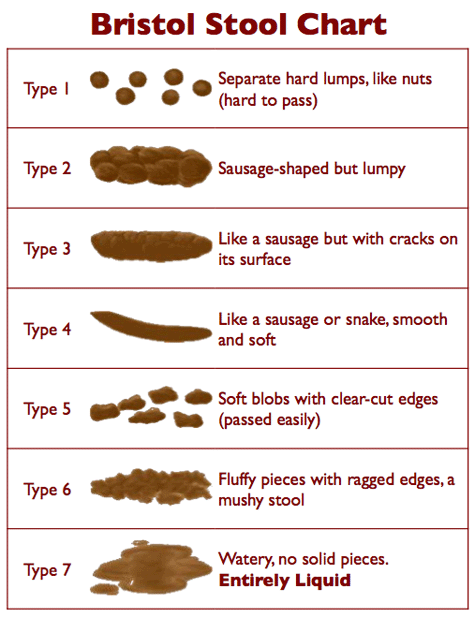
|
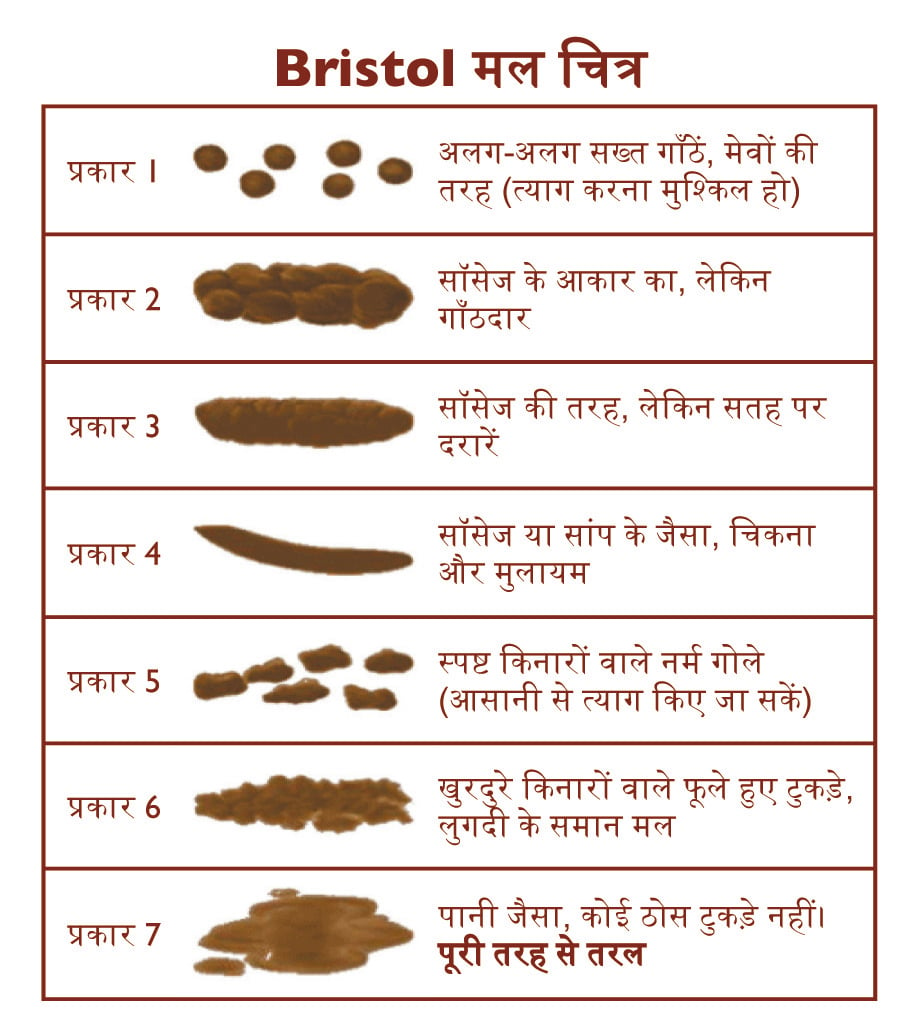
|
Common Bowel Problems
Faecal Impaction– When constipation causes faeces to pack the intestine (digestive tract) so tightly that your normal pushing action in the toilet is not strong enough to push the faeces out.
Faecal Incontinence (sometimes referred to as ‘soiling’) – This is the accidental loss of liquid or solid faeces. This can be due to the bowel (which stores the faeces) being too full, but this may be only one of the causes. Uncontrolled flatus (‘wind’) is often considered evidence of faecal incontinence.
Haemorrhoids (sometimes referred to as ‘piles’) – This can be the result of straining to have a bowel movement. This strain (similar to heavy lifting) can damage the rectum’s veins. This can cause bleeding, soreness and itching.
Rectal Prolapse – This occurs when long‐term straining causes a small amount of bowel lining to push out from the anus, which is a ring of muscle that opens and closes when we pass a bowel motion.
|
आँत की आम समस्याएँ
कसा हुआ मल – जब कब्ज मल पर दबाव डालकर उसे इतना कस देता है कि आँत (पाचन नलिका) पैक हो जाए और शौचालय में आपकी सामान्य रूप से जोर लगाने की क्रिया से मल बाहर न निकले।
मल असंयम (जिसे कभी-कभी 'सॉयलिंग' भी कहा जाता है) - यह आकस्मिक तरीके से तरल या ठोस मल का निकलना होता है। यह आँत (जोकि मल का सँचय करती है) के बिल्कुल पूरी तरह से भरे हुए होने के कारण हो सकता है, लेकिन यह अनेक कारणों में से केवल एक ही है। अनियंत्रित आंत्रवायु ('विंड') को अक्सर मल असंयम होने का सबूत माना जाता है।
बवासीर (जिसे कभी-कभी 'पाइल्स' भी कहा जाता है) – यह मल-त्याग करने के लिए अत्यधिक दबाव डालने के परिणामस्वरूप हो सकता है। दबाव डालने से (जोकि भारी सामान उठाने के समान होता है) मलाशय की नसों को नुकसान पहुंच सकता है। इससे खून निकल सकता है व दर्द और खुजली पैदा हो सकती है।
गुदा का प्रोलैप्स – यह लंबी अवधि के दौरान दबाव डालने के कारण होता है, जिसमें आँत की कुछ माँस-पेशियाँ गुदा-द्वार या एनस से बाहर निकल आती हैं। गुदा-द्वार माँस-पेशियों का एक घेरा होता है जो मल-त्याग करते समय खुलता और बंद होता है।
|
How constipation affects bladder control
- Constipation can cause accidential leakage from your bladder.
- An overfull bowel will cut down the volume of urine your bladder can hold and you will feel the need to go to the toilet often and in a hurry.
|
कब्ज मूत्राशय नियंत्रण को कैसे प्रभावित करता है
- कब्ज के कारण आपके मूत्राशय से आकस्मिक रिसाव हो सकता है।
- एक पूरी तरह से भरी हुई आँत आपके मूत्राशय द्वारा संग्रहित की जाने वाली मूत्र की मात्रा को कम कर देगी और आपको अक्सर और जल्दी में शौचालय जाने की ज़रूरत महसूस होगी।
|
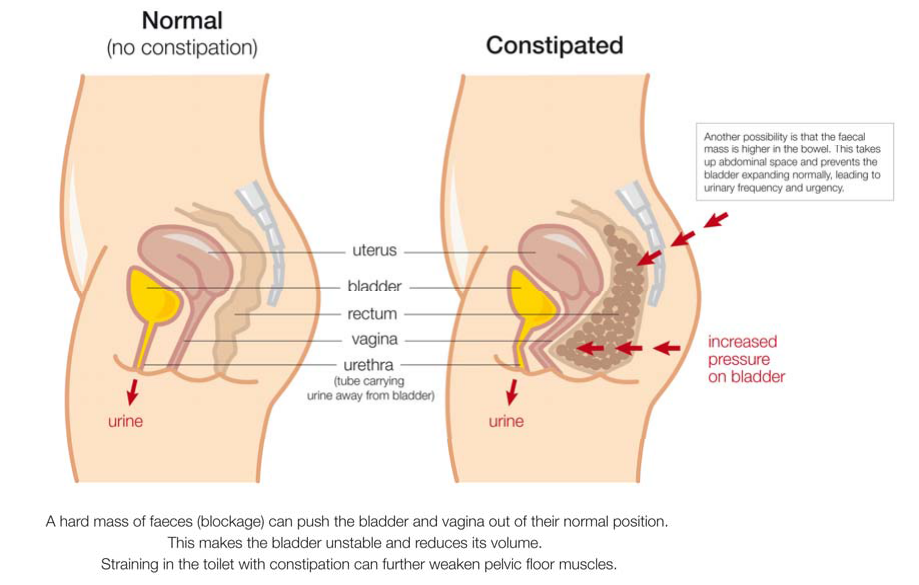 |
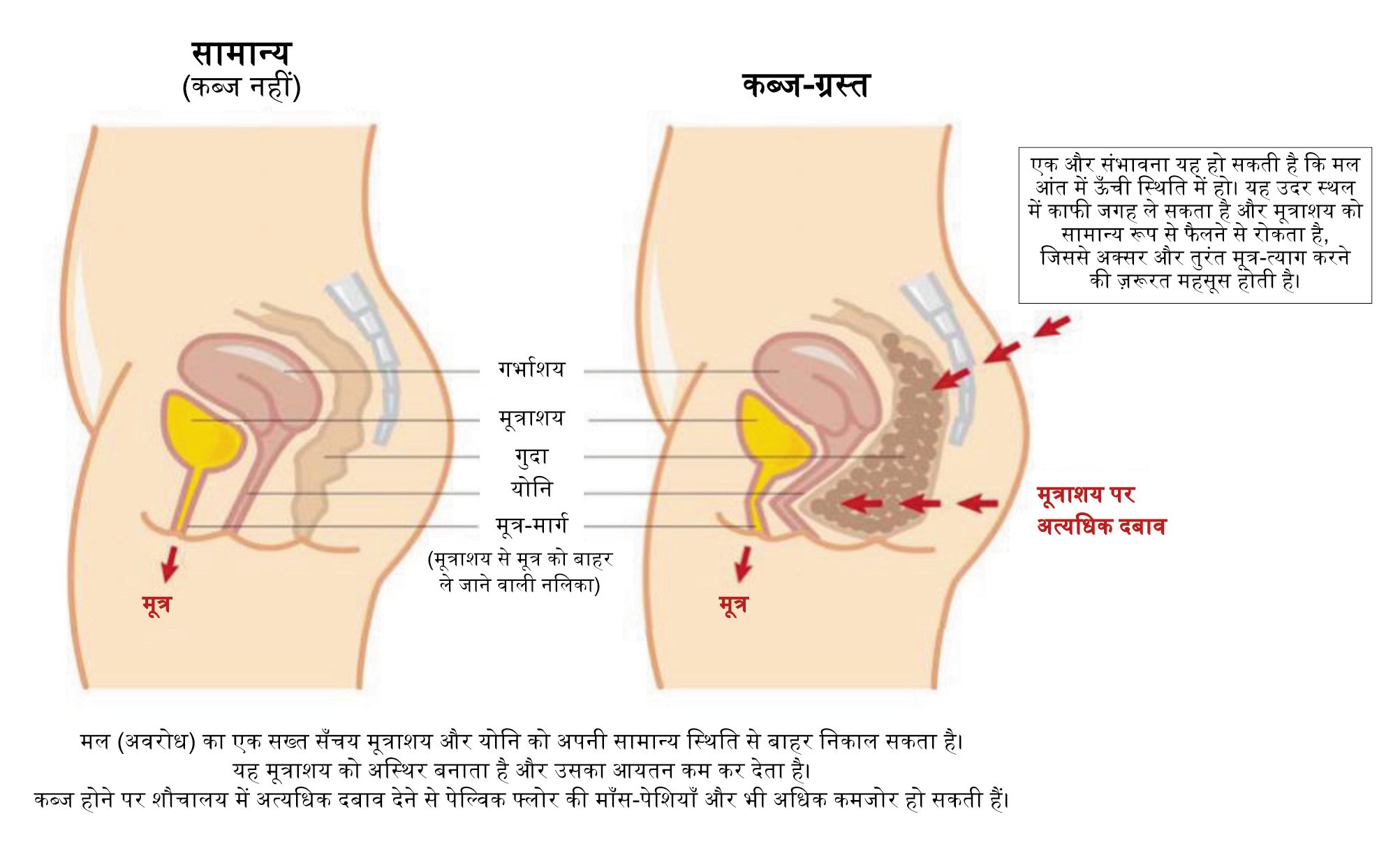 |
Here are five ways to keep your bladder and bowel healthy and prevent constipation:
- Eat well to keep your bowels regular and to have a healthy body weight
Eat a healthy diet high in fibre (at least 30g per day).
- Drink well to prevent constipation and bladder irritation Drink 1.5 -2 Litres(6-8 glasses) of fluid each day unless advised otherwise by your doctor. Fluid is water, fruit juice, tea, coffee, milk, soup, jellies and icecream.
- Exercise daily to prevent constipation and keep a healthy body weight
- Keep your pelvic floor strong for good bladder and bowel control Request a pelvic floor muscle exercise leaflet by calling the National Continence Helpline 1800 33 00 66.
- Toileting habits – Go to the toilet as soon as you need to and empty your bowel fully. Remember to relax.
|
ये आपके मूत्राशय और आंत को स्वस्थ रखने और कब्ज से बचाव करने के पाँच तरीके हैं:
- अपनी आंत को नियमित बनाए रखने और शरीर का स्वस्थ वजन बनाए रखने के लिए अच्छे आहार का सेवन करें
उच्च मात्रा में रेशों वाला (प्रति दिन कम से कम 30ग्रा) एक स्वस्थ आहार लें।
- कब्ज और मूत्राशय में जलन रोकने के लिए अच्छी तरह से पेय-पदार्थों का सेवन करें यदि आपके चिकित्सक ने अन्यथा सलाह न दी हो, तो हरेक दिन 1.5 - 2 लीटर (6-8 गिलास) तरल पदार्थ का सेवन करें। तरल-पदार्थों में पानी, फलों का रस, चाय, कॉफी, दूध, सूप, जेली और आइसक्रीम शामिल हैं।
- कब्ज से बचाव करने और शरीर का स्वस्थ वजन बनाए रखने के लिए हरेक दिन व्यायाम करें
- मूत्राशय और आँत के अच्छे नियंत्रण के लिए अपने पेल्विक फ्लोर को मजबूत बनाए रखें राष्ट्रीय संयम हेल्पलाइन को 1800 33 00 66 पर फोन करके एक पेल्विक फ्लोर माँस-पेशी व्यायाम पत्रक के लिए अनुरोध करें।
- शौचालय की आदतें – जैसे ही आपको ज़रूरत महसूस हो, तुरंत शौचालय जाएँ और अपनी आंत को पूरी तरह से खाली करें। आराम करना याद रखें।
|
Check your toileting postion:
- Your knees should be raised slightly above the level of your hips
- A small footstool might be needed to get you into the best position
- See the diagram below for further help
|
शौचालय की कुर्सी पर अपने बैठने की स्थिति की जाँच करें:
- आपके घुटनों को आपके कूल्हों के स्तर से थोड़ा ऊपर उठा हुआ होना चाहिए
- आपको सबसे अच्छी स्थिति में लाने के लिए एक छोटे से फुटस्टूल की आवश्यकता हो सकती है
- और अधिक मदद के लिए नीचे चित्र देखें
|
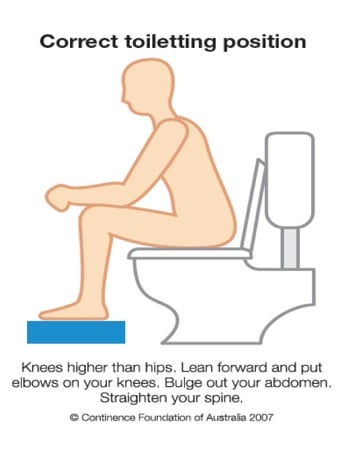 |
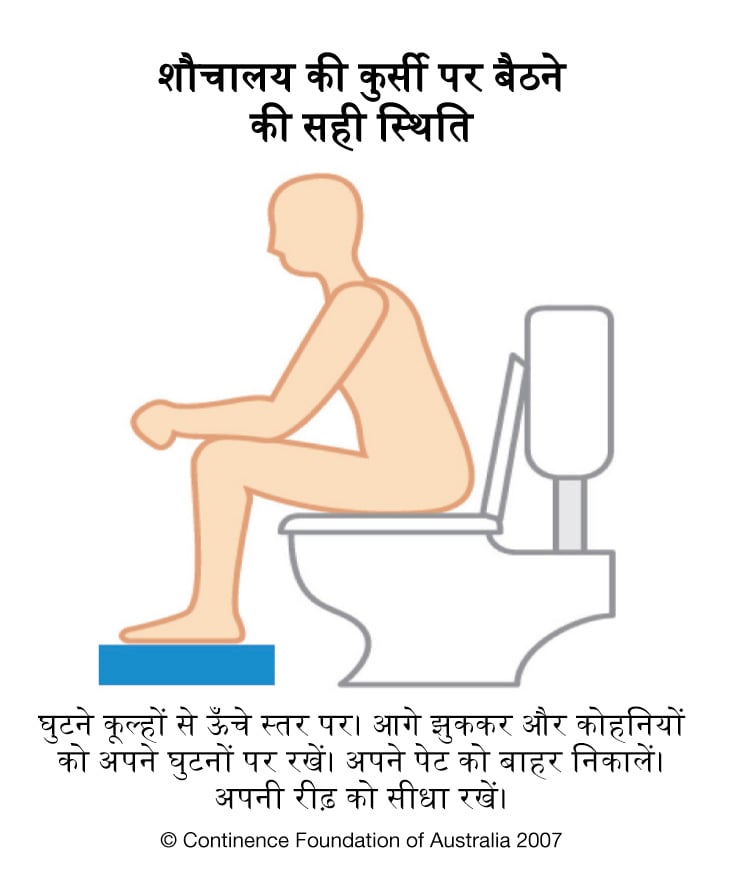 |
Laxatives
- Laxatives are medicines that will help loosen the bowel motion to prevent blockages and straining.
- Talk to your doctor about using these.
- Generally, laxatives should only be taken for short periods of time.
There are three types of laxatives:
- Bulking Agents – These increase the bulk of the stool (faeces). Drinking at least 6‐8 glasses of fluid daily is essential.
- Lubricant Laxatives – These soften the faeces and make them easier to pass.
- Stimulant/Irritant Laxatives – These make the bowel more active in moving faeces through the bowel.
If constipation is severe or continuing, go to your Doctor.
|
जुलाब (लैक्सेटिव)
- जुलाब अवरोधों और तनाव को रोकने के लिए मल-त्याग को ढीला करने में मदद देने वाली दवाइयाँ होते हैं।
- इनका उपयोग करने के बारे में अपने चिकित्सक के साथ बात करें।
- आम-तौर पर जुलाब का प्रयोग केवल कम अवधि के लिए ही किया जाना चाहिए।
जुलाब के तीन प्रकार के होते हैं:
- बल्किंग एजेंट – ये मल के आयतन में वृद्धि करते हैं। प्रतिदिन कम से कम 6-8 गिलास तरल-पदार्थ पीना आवश्यक है।
- चिकनाई वाले जुलाब – ये मल को नरम बनाते हैं और मल-त्याग करना आसान बनाते हैं।
- उत्तेजक/क्षोभक जुलाब – ये मल को आगे बढ़ाने में आँत को और अधिक सक्रिय बनाते हैं।
यदि कब्ज गंभीर है या लगातार बना रहता है, तो अपने चिकित्सक के पास जाएँ।
|
Who can help?
The first step to improving your bowel control is to have a full continence assessment carried out by a health professional.
For more information
There are a range of health professionals who can help you deal with constipation.
- Visit your GP or specialist
- Telephone a Continence Nurse Advisor on the National Continence Helpline 1800 33 00 66
- To use an interpreter, ring the Translating and Interpreting Service (TIS) on 13 14 50
|
कौन मदद कर सकता है?
आपके आँत नियंत्रण में सुधार करने के लिए सबसे पहला कदम यह है कि किसी स्वास्थ्य पेशेवर द्वारा एक पूर्ण संयम मूल्यांकन किया जाए।
और अधिक जानकारी के लिए
ऐसे अनेकानेक स्वास्थ्य पेशेवर हैं जो आपको कब्ज से निपटने में सहायता दे सकते हैं।
- अपने जीपी या विशेषज्ञ के पास जाएँ
- राष्ट्रीय संयम सहायता लाइन 1800 33 00 66 पर एक संयम नर्स सलाहकार को फोन करें
- दुभाषिए का उपयोग करने के लिए 13 14 50 पर अनुवाद और दुभाषिया सेवा (टीआईएस) को फोन करें
|







